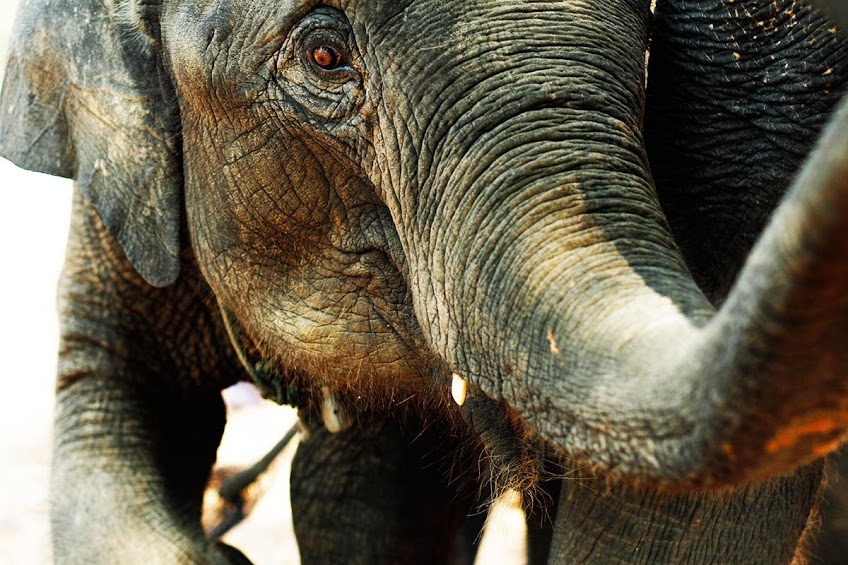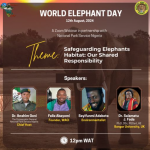What’s Up for Elephants
Founder’s Note:
This year marks our 6th Annual World Elephant Day campaign. We here at World Elephant Day are very proud of how the day has grown year after year after year. Our global media reach continues to blossom, signifying that our impact is ever-expanding — which means that increasing numbers of people are becoming conscious about what’s really at stake for the elephants.
For World Elephant Day, one of our goals has been to put together an annual review of what’s happened in the world for elephants over the past year: the milestones, the successes, and the work that still needs to be done.
For this year’s review, our guest writer is Erika Mansourian, a well-known and passionate elephant advocate and conservationist who has worked with several elephant organizations. Anne Dillon, our Communications Director, works in a variety of capacities on behalf of the elephants. She provided background research for this report, as well as editorial support in the writing of it.
We hope you enjoy it and we look forward to your feedback amid the rumblings and trumpeting currently underway for World Elephant Day 2017!
Elephantically yours,
Patricia Sims
Co-Founder, World Elephant Day
President, World Elephant Society
What are the encouraging developments and the intractable challenges from the world of elephants since last August 12th? We’ll try to take that on in this update, which focuses on the state of the extraordinary but beleaguered elephant. The landscape for elephants, literally and figuratively, continues to shift, so there is more news than we can possibly cover. But here are some highlights, shared with the hope that both the good news and the bad will motivate you to commit your time, skills, and creativity to saving the most worthy of animals. Our greater hope is that one year soon we will be able to report even more positive progress and fewer grim statistics.
In December, China made a stunning announcement: it will ban all commerce in ivory by the end of 2017. Coming from the world’s largest consumer of ivory, the move may deal a blow to elephant poaching in Africa. This follows on the heels of the Obama administration’s near total ban on the commercial trade in elephant ivory. Hong Kong says it intends to ban ivory by 2021, Japan’s internet retail giant Rakuten Ichiba has ended all sales of elephant ivory, and there have recently been high-profile trafficking busts throughout Southeast Asia, Europe, and the U.S., signaling that the noose is tightening around traffickers of (primarily African) ivory. Of course, far more must be done to reduce the supply, demand, and killing.
That said, with a handful of bold actions offering a glimmer of hope for the African elephant, this year we’d like to emphasize the ongoing plight of the Asian elephant, both wild and captive.
Captive Asian Elephants: A Pachyderm Paradox
There is a stark contradiction in the current state of captive Asian elephant welfare.
Growing Awareness, Changing Behavior
- Well-meaning but uninformed tourists are becoming more aware of the gruesome reality behind the scenes at elephant riding camps and venues where elephants are forced to perform. According to World Animal Protection, 60% of the people it surveyed said they would avoid tour operators whose activities cause suffering to wild animals.
- Circuses that exploit exotic animals are closing down due to diminishing sales, including the most famous of them all, Ringling Bros.
- Legitimate sanctuaries such as Elephant Sanctuary Brazil are opening.
- Ethical elephant tourism guides and lists of places to consider visiting are currently available; they offer advice as to best practices for interacting with and viewing captive elephants and various forms of wildlife.
- Some safari camps are no longer offering rides and other places never have.
- More than 160 travel companies have signed a pledge to stop promoting and selling travel packages that include elephant entertainment. (For a full list of elephant-friendly travel companies, visit World Animal Protection’s site. They include Peregrine, Albatross Travel, Jetair, Qantas Vacations, AAT Kings, APT, Helloworld, Harvey World Travel, and Expedia.)
Elephant Exploitation: Progress is Slow and in Some Places, the Situation is Worsening
Over 3,000 captive elephants in Asia are enduring abuse and neglect, living for years in chains when they’re not being forced to carry heavy burdens of tourists or perform unnatural and painful tricks. Sadly, between 2010 and 2016 there has been a 30% rise in the number of elephants used in tourism in Thailand.
The exportation of wild elephants into captivity is a deflating indication that demand for entertainment and tourism is, in some areas, still thriving. In December, Zimbabwe airlifted 35 wild elephants to a zoo in China, some as young as three years old. As can be imagined, the transport was a living hell for the animals. This June, it was revealed that the Namibian government planned to capture and sell five baby elephants to the Dubai Safari Park in United Arab Emirates. It is believed the elephants would be used for riding, so the brutal practice of “breaking” them in is inevitable.
Wild Asian Elephants: The World Closes In
Human-Elephant Conflict
The problem is straightforward: Too many people and not enough space for elephants. The causes are not as simple — there a just too many of them.
Human population growth threatens elephant territory, most notably ancient migration corridors that elephants have trod for millennia. Seeking new routes, they’re frequently struck by trains or electrocuted. Nearly 300 wild elephants died in India’s Orissa State in the past five years; most of the deaths were caused by accidental electrocution. More than 1,200 trains crisscross the country, through some of the most vulnerable wildlife habitats. In the past three years alone, 40 elephants have been killed by trains in India, according to the government.
Elephants in search of food and water frequently rampage villages and attack villagers, who kill them. In Odisha, 388 elephants died in man-animal conflict in just six years.
Industrial development such as the palm oil trade in Sumatra and logging camps and infrastructure expansion choke off the highly limited land for elephants and other wildlife.
Poaching and illegal trafficking is an ongoing scourge throughout India and Asia.
Perhaps most heartbreaking is the capture and smuggling of wild baby elephants in Burma, Laos, Cambodia, Myanmar, and elsewhere to feed the appetite of the tourism trade.
Solutions Planned or in Place
The solutions for protecting wild elephants can be as varied as the problems. Recently, a panel of experts shared their ideas for better co-existence. Foremost is pushing conservation to a higher priority on the political agenda, giving a voice to suffering human communities, and promoting the intrinsic value of elephants.
Corridors and Underpasses
In India alone there are 88 wild elephant corridors, making it impossible to secure them all. But both government agencies and NGO alliances are expending resources to create sustainable spaces for jumbos. Villagers are voluntarily relocated to safer areas to ensure their peace of mind, such as 38 families in Assam, India, in 2016.
To address strikes by trains, providing the Indian public with a more complete list of elephant-crossings and lowering train speeds in those areas will hopefully reduce the number of elephant deaths. Beehive fences are increasingly being used to deter crop-raiding pachyderms. The cost is low relative to their effectiveness.
The future of the Asian elephant can seem unnervingly precarious. For many conservation organizations, agencies, and individuals, though, giving up is not an option.
African Elephant Update
As with the Asian elephant, the past 12 months have brought some surprisingly promising news from some African countries, but also a continuing downward trend in others. Census results reflect the contradiction.
Numbers Up, Numbers Down
According to an aerial survey by the Kenya Wildlife Service, there has been a 72% increase in the number of elephants in the Maasai Mara Conservancy and the Tsavo-Mkomazi ecosystems since 2014, and poaching in Kenya generally saw a decline in 2016. It goes without saying — but we’ll repeat the refrain anyway — upticks like these are relatively slim. Kenya will complete a broader elephant survey by the end of 2018.
A shocking 730,000 elephants are missing across 73 protected areas in southern Africa, according to a new study from the University of Pretoria (UP).
Perhaps most troubling of all, this spring an aerial survey of a large swath of northern Central African Republic (CAR), conducted with funding from the Great Elephant Census, a Paul G. Allen Project, observed no elephants at all, nor even any sign of them. Surveys of the area in 1977 estimated 35,093 elephants; by 2010 only an estimated 68 elephants remained in the landscape.
Keeping the Faith: Steady Steps Yield Sustainable Results
Three tourism agencies in China have stated that they will phase out their promotion of elephant riding, and other forms of entertainment at the elephants’ expense, in the travel destinations of India, Sri Lanka, and Nepal.
Beehive fences are being increasingly used in Africa (where they originated). In Gabon — home to 45,000 forest elephants — electric fences are allowing people and elephants to better co-exist.
Elephant riding camps in Botswana and South Africa have ended the practice.
Malawi is in the midst of relocating a total of 500 elephants from the Lower Shire district of Chikwawa to the country’s central grasslands and woodlands.
There has been a decline in the legal trade in China. Indeed, that country’s resolve to ban its legal commercial ivory trade has sparked a dramatic downturn in ivory prices throughout Asia, including in Bangkok’s black market.
For decades Japan has ignored an international ban on poached ivory. Now it’s taking small but meaningful steps to join other countries, while giant retailers also commit to stop the sale of ivory products.
On the trafficking side, in June a cross-border African task force cracked a major ivory trafficking ring moving ivory from Uganda to Singapore by way of Kenya, and in July, the Environmental Investigation Agency published news that the small town of Shuidong in Guangdong province in southern China has been a seminal ivory trafficking hub; 80% of all poached ivory from Africa passes through this one pivot point.
CITES 2016
African elephants and rhinos were front and center at the 17th Conference of the Parties (CoP17) to the Convention on International Trade in Endangered Species (CITES), held in Johannesburg last October. Held every three years, with 183 member countries, the conference had 62 individual proposals under consideration, but with an unprecedented 30% decline in the African elephant population between 2007 and 2014, elephants were high on the agenda. In the past, CITES has sometimes frustrated conservationists with its decisions mired in political interests, but this year it is believed to have had more highs than lows for wildlife protection.
Bans for Conservation and Welfare
Here are a few of the notable rulings and ivory-ban legislation from around the world.
As the largest city in the world, in July of this year New York City set a powerful example by banning all performing exotic animals, and a ban on the use of elephants in entertainment is awaiting the governor’s signature in New York State.
According to the Humane Society of the US, ivory sales are currently illegal in California, New Jersey, New York, Hawaii, Oregon, and Washington State. This year, Nevada joined their ranks. Ivory-ban legislation is being considered in Nebraska, Pennsylvania, Delaware, and Massachusetts.
On the world stage, France announced an ivory ban last August, and last month Hong Kong launched a bill that would ban the import and export of ivory by 2021.
Over in the UK, the Labour Party Manifesto 2017 is calling for a total ban on trade in ivory. Prime Minister Theresa May abandoned her previous commitment to a ban. A startling report last August revealed that thousands of ivory products are on sale throughout Britain. On the upside, last November the country pledged £13 Million ($17 million) to tackle illegal wildlife trade.
Deploying More Tech Tools
The tech industry was initially sluggish in contributing their innovations and products to the battle to save elephants. Rangers, law enforcement, guards, and communities relied on their weapons, their eyes and ears, and a simple determination to protect their wildlife. Now, Silicon Valley is teaming up with conservation organizations, and everything from solar fences to GPS telemetry to whatsapp is helping to level the playing field.
Microsoft co-founder Paul Allen, whose Great Elephant Census was as comprehensive as it was alarming, wants to cover 90,000 square miles of Africa with smart sensors and drones by the end of the year: the Domain Awareness System (DAS) is the most ambitious tech-focused conservation project yet.
Cutting edge DNA barcoding, which uses short DNA sequences to accurately identify species, is becoming an effective courtroom tool for prosecuting wildlife crime. With a grant from Google, the Barcode for Wildlife Project has trained hundreds of law enforcement officials and scientists to use the technology in South Africa and Kenya.
To Crush or Not to Crush?
This month, New York City once again held a crush, destroying two tons of ivory worth about $8 million. Other crushes have been held in other countries around the world. But are they effective? Or do they do more harm than good? This piece asks several wildlife experts for their opinion on the controversial strategy.
The Power of One
Never underestimate the power of one person to make a difference. Stephanie Vergniault fell in love with elephants on her first visit to Chad in 1995, when she saw them in great numbers. As she watched them disappear, the French native knew she had to act. She founded SOS Elephants, the first organization of its kind in Chad, through which she has built support for the anti-poaching cause. The result is that, although challenges remain, elephant protection has become a high priority in Chad.
Fascinating Findings about an Already Fascinating Animal
Each year, new research increases our respect and admiration for the elephants (if that’s even possible).
- Elephants know when their bodies are obstacles to success in a novel transfer task
- Genetic study shakes up family tree
- Elephants born without tusks due to poaching
Alarming Trends
There is a horrific, invasive cactus in Kenya that can kill an elephant when its spines become lodged in the animal’s throat or stomach.
SA National Parks in South Africa is refusing to provide statistics on how many elephants have been poached in Kruger National Park this year. Queries are referred to the Dept. of Environmental Affairs (DEA), which likewise declines to release the figures.
An emerging threat to elephants is skinning — being killed and stripped of their skin, which is sold on the black market, promoted as a medicinal cure or made into beads. The recent discovery of 421kg of elephant skin seized in southwest China confirms this devastating market development.
Wildlife traffickers are using Facebook to sell ivory and rhino horn.
The Telltale Conclusion
The pressures coming at the elephants come from all sides — climate change, toxic land and water, global unrest, and the Sixth Mass Extinction that is well underway. Our most precious resource is the one we can’t make more of: land. How are we to make the most of what we have? How can we preserve the few wild spaces left, to ensure that flora and fauna will survive, and maybe even thrive? It requires innovation, collaboration, and long-term resolve.
For things you can do for elephants all year long, check out World Elephant Day’s ideas and actions. To quote the British explorer Robert Swan, “The greatest threat to our planet is the belief that someone else will save it.”
With that in mind, we’d like to leave you with a thought-provoking question that we’ve dubbed the “One Question, One Word” challenge. Come up with one word to describe what you think is the single most effective tool for saving elephants. And, in three sentences or less, tell us why.
We’ve asked a few elephants conservationists and welfare experts for their views on this; below are their replies.
Send your word and explanation to info@worldelephantday.org with the subject line
“One Question, One Word” and we’ll share all of your hopeful words with the world in our next newsletter.
- Compassion
Most wild animal species that are declining can be considered ecological refugees. If we can invoke compassion in the minds of the pubic for a sentient being that bears so many similarities to us, we can create a powerful force for elephant conservation.
Compassion, or Karuna, is an important concept in Buddhism: the desire to remove harm and suffering from others. Karuna works with Muditha, which is the desire to bring about the well-being and happiness of others.
—Ravi Corea, President, Sri Lanka Wildlife Conservation Society
- Influence
If we, as the governing species on our planet, do not speak up on behalf of elephants and the forests, land, and water that we all need, who will?
—Monica Wrobel, Head of Conservation and Campaigns, Elephant Family
- Community
Elephants will survive best when the community has security, education, and livelihoods.
—Denis Galava, African Wildlife Foundation
- Passage
Elephants are large animals (megaherbivores) and need to constantly move to feed. Unless their right of passage is established over these traditional migratory routes, there will be higher conflict rates and fewer elephants in the future.
—Vivek Manon, Founder and CEO, Wildlife Trust of India
- Oneness
Oneness is important in the elephant welfare movement, as it will create unity, and foster symbiotic relationships. As seen in the natural world where organisms thrive together, we can manifest changes by embracing each other’s unique talents, rather than compete or imitate. Every human being has an authentic and necessary gift that needs to be harnessed in order to bring an end to the atrocities against these supremely intelligent and noble animals.
—Sangita Iyer, Founder and President, Voice for Asian Elephants Society and filmmaker of Gods in Shackles
- Integrity
Integrity is key to making a difference overall, because without it amongst all groups involved with elephant protection — from rangers to conservation officials to law enforcers to prosecutors and judges and politicians, as well as funders and NGOs — elephants will not be saved. In every population where poaching is out of control, there is a lack of integrity among at least one of these groups — those who are entrusted to enforce laws and protect wildlife.
—Wayne Lotter, Founder of PAMS Foundation, Tanzania
- Land
Nearly everywhere in Asia elephants are threatened by encroachment on their habitat. India, where humans outnumber elephants by about 50,000 to 1, is a prime example. While it is hard not to sympathize with poor farmers terrorized by crop-raiding elephants, human usurpation of the elephants’ land is illegal, even immoral, and must be stopped.”
—Richard Lair, Consultant on Asian Elephants
- Hope
Hope alone won’t save the elephants, but without it, we don’t stand a chance. With hope comes the belief and the action necessary for us to save the magnificent elephants from extinction.
—Patricia Sims, Co-Founder, World Elephant Day, President, World Elephant Society, Filmmaker of When Elephants Were Young
In our two previous newsletters this year we included excerpts from a prescient message that the renowned French writer Romain Gary (1914–1980) wrote to the elephants, as expressed in a letter published in LIFE magazine in 1967, fifty years ago. We end this update with some more of his words here:
“We never met again, and yet in our thwarted, restricted, controlled, indexed and repressed existence, the echo of your irrepressible thundering march through the open spaces of Africa keeps reaching me, awakening a confused longing. It sounds triumphantly like the end of acceptance and servitude . . . and for all of us who are sick and tired of our polluted cities and even more polluted minds, your colossal presence and the fact of your survival against all odds acts as a God-sent reassurance.
Everything is not yet lost, the last hope of freedom has not yet vanished completely from this earth and, who knows, if we stop destroying elephants and save them from extinction, we may yet succeed in protecting our own species from our destructive enterprises as well.”
Click to download the 2017 World Elephant Day Review





